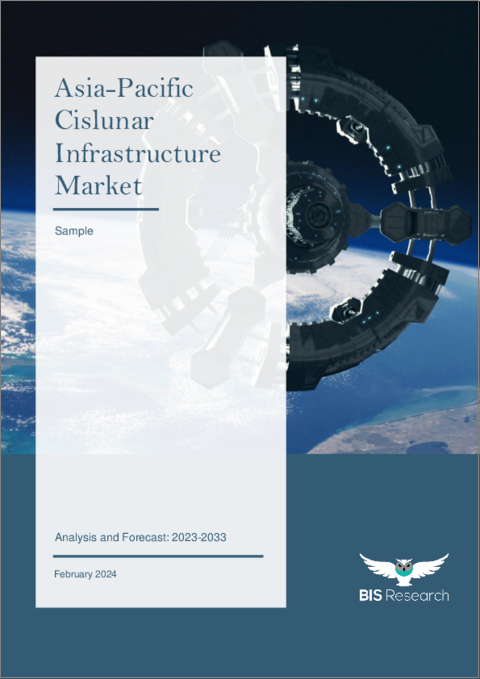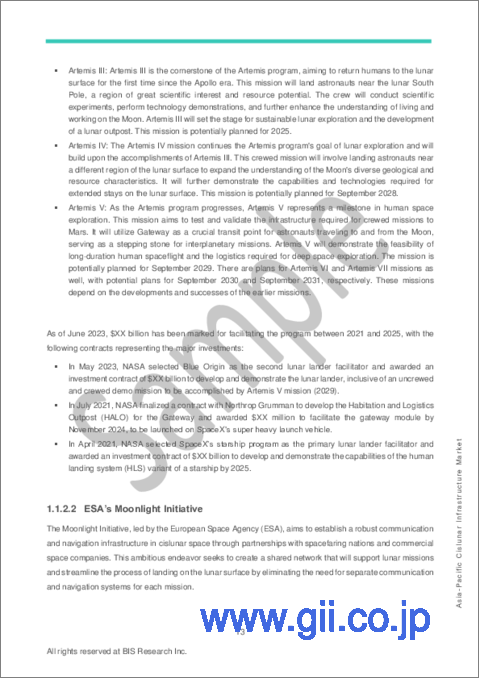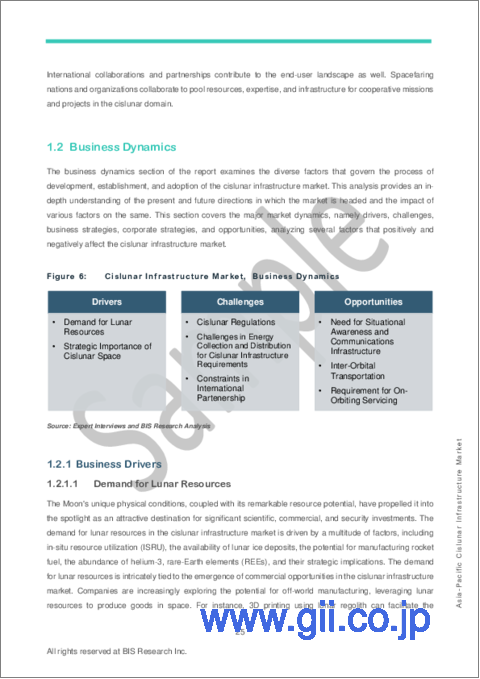|
|
市場調査レポート
商品コード
1422244
アジア太平洋のシスルナーインフラ市場:分析と予測(2023年~2033年)Asia-Pacific Cislunar Infrastructure Market: Analysis and Forecast, 2023-2033 |
||||||
カスタマイズ可能
|
|||||||
| アジア太平洋のシスルナーインフラ市場:分析と予測(2023年~2033年) |
|
出版日: 2024年02月09日
発行: BIS Research
ページ情報: 英文 69 Pages
納期: 1~5営業日
|
全表示
- 概要
- 図表
- 目次
アジア太平洋のシスルナーインフラの市場規模は、2023年の8億1,000万米ドルから2033年には24億9,000万米ドルに達すると予測され、予測期間の2023年~2033年の成長率は11.96%になるとみられています。
シスルナーインフラ分野の成長は、宇宙機関、民間企業、パートナーシップによる、強力で環境的に持続可能なシスルナー環境構築への関心の高まりによって推進されています。
| 主要市場統計 | |
|---|---|
| 予測期間 | 2023年~2033年 |
| 2023年評価 | 8億1,000万米ドル |
| 2033年予測 | 24億9,000万米ドル |
| CAGR | 11.96% |
アジア太平洋では、推進システム、通信システム、宇宙ステーション、宇宙輸送、資源利用という5つの主な要因によって、太陽系インフラ開発が勢いを増しています。推進システム、通信システム、宇宙ステーション、宇宙輸送、資源利用です。推進システムと通信の進歩には多額の投資が行われてきたが、現在では宇宙ステーション、宇宙輸送、資源利用の課題解決に注目が集まっています。アジア太平洋地域の宇宙探査と協力へのコミットメントは、持続可能な太陽系プレゼンスへの関心を高めています。最近の進歩には、推進力の改善や再使用可能な打ち上げロケットなどがあります。現在では、信頼性の高い通信と、宇宙輸送ソリューションの需要を満たすことに重点が置かれています。シスルナーインフラストラクチャーは、長期の月ミッション、科学探査、潜在的な天体ベンチャーにとって極めて重要であり、シスルナー特有の環境に合わせて設計され、安全な運用と資源利用を可能にし、市場の成長を支えています。
当レポートでは、アジア太平洋のシスルナーインフラ市場について調査し、市場の概要とともに、技術別、国別の動向、および市場に参入する企業のプロファイルなどを提供しています。
目次
エグゼクティブサマリー
調査範囲
第1章 市場
- 業界の展望
- ビジネスダイナミクス
第2章 地域
- 太古のインフラ市場(地域別)
- アジア太平洋
- 市場
- 製品
- アジア太平洋(国別)
第3章 市場-競合ベンチマーキングと企業プロファイル
- 競合ベンチマーキング
- 主要参入企業のプロファイル
第4章 調査手法
List of Figures
- Figure 1: Asia-Pacific Cislunar Infrastructure Market, $Billion, 2022-2033
- Figure 2: Asia-Pacific Cislunar Infrastructure Market (by Technology), $Billion, 2022 and 2033
- Figure 3: Cislunar Infrastructure Market (by Region), $Billion, 2033
- Figure 4: Supply Chain Analysis
- Figure 5: Value Chain Analysis
- Figure 6: Cislunar Infrastructure Market, Business Dynamics
- Figure 7: Share of Key Market Developments, January 2020- June 2023
- Figure 8: Competitive Benchmarking
- Figure 9: Research Methodology
- Figure 10: Top-Down and Bottom-Up Approach
- Figure 11: Assumptions and Limitations
List of Tables
- Table 1: Startups and Investments, January 2020-June 2023
- Table 2: Category of Launchers and Lunar Lander Facilitators
- Table 3: Launchers and Lunar Lander Facilitators Developments
- Table 4: Category of In-Space Logistics Facilitators
- Table 5: Category of Cislunar Communication Providers
- Table 6: Mergers and Acquisitions, January 2020- June 2023
- Table 7: Partnerships, Collaborations, Agreements, and Contracts, January 2020-June 2023
- Table 8: Cislunar Infrastructure Market (by Region), $Billion, 2022-2033
- Table 9: Asia-Pacific Cislunar Infrastructure Market (by Technology), $Billion, 2022-2033
- Table 10: China Cislunar Infrastructure Market (by Technology), $Billion, 2022-2033
- Table 11: India Cislunar Infrastructure Market (by Technology), $Billion, 2022-2033
- Table 12: Japan Cislunar Infrastructure Market (by Technology), $Billion, 2022-2033
- Table 13: Rest-of-Asia-Pacific Cislunar Infrastructure Market (by Technology), $Billion, 2022-2033
- Table 14: Key Player Profiles
“The Asia-Pacific Cislunar Infrastructure Market Expected to Reach $2.49 Billion by 2033.”
Introduction to Asia-Pacific Cislunar Infrastructure Market
The Asia-Pacific cislunar infrastructure market is estimated to reach $2.49 billion by 2033 from $0.81 billion in 2023, at a growth rate of 11.96% during the forecast period 2023-2033. The growth of the cislunar infrastructure sector is propelled by a growing fascination from space agencies, private enterprises, and partnerships in building a strong and environmentally sustainable cislunar environment.
| KEY MARKET STATISTICS | |
|---|---|
| Forecast Period | 2023 - 2033 |
| 2023 Evaluation | $0.81 Billion |
| 2033 Forecast | $2.49 Billion |
| CAGR | 11.96% |
Market Introduction
In APAC, cislunar infrastructure development is gaining momentum due to five key factors: propulsion systems, communication systems, space stations, in-space transportation, and resource utilization. Progress in propulsion and communication has seen substantial investment, while attention is now shifting to address challenges in space stations, in-space transport, and resource use. APAC region's commitment to space exploration and collaboration fuels interest in a sustainable cislunar presence. Recent progress includes improved propulsion and reusable launch vehicles. Efforts now focus on reliable communication and meeting demand for in-space transport solutions. Cislunar infrastructure is crucial for long lunar missions, scientific exploration, and potential celestial body ventures, designed for the unique cislunar environment to enable safe operations and resource utilization, supporting market growth.
Market Segmentation:
Segmentation 1: by Technology
- Propulsion Systems
- Communication Systems (Relay Satellites)
- Space Stations
- In-Space Transportation Vehicles
Segmentation 2: by Country
- China
- Japan
- India
- Rest-of-Asia-Pacific
How can this report add value to an organization?
Product/Innovation Strategy: The product segment helps the reader to understand the different types of solutions available for deployment and their potential. Moreover, the study provides the reader with a detailed understanding of the cislunar infrastructure market by technology, inclusive of the key developments in the respective segments.
Growth/Marketing Strategy: The cislunar infrastructure market has seen some major development by key players operating in the market, such as partnership, collaboration, and joint venture. The favored strategy for the collaboration between government space agencies and private players is primordially contracting the development and delivery of the key segments of the cislunar infrastructure ecosystem.
Table of Contents
Executive Summary
Scope of the Study
1. Market
- 1.1. Industry Outlook
- 1.1.1. Cislunar Infrastructure Market: Overview
- 1.1.2. Ongoing and Upcoming Programs
- 1.1.2.1. NASA's Lunar Orbital Platform-Gateway
- 1.1.2.2. ESA's Moonlight Initiative
- 1.1.2.3. ULA Cislunar-1000
- 1.1.2.4. China National Space Administration's (CNSA) International Lunar Research Station (ILRS)
- 1.1.2.5. CSA's Lunar Exploration Accelerator Program (LEAP)
- 1.1.3. Startups and Investment Landscape
- 1.1.4. Supply Chain Analysis
- 1.1.5. Value Chain Analysis
- 1.2. Business Dynamics
- 1.2.1. Business Drivers
- 1.2.1.1. Demand for Lunar Resources
- 1.2.1.2. Strategic Importance of Cislunar Space
- 1.2.2. Business Challenges
- 1.2.2.1. Cislunar Regulations
- 1.2.2.2. Challenges in Energy Collection and Distribution for Cislunar Infrastructure Requirements
- 1.2.2.3. Constraints in International Partnership
- 1.2.3. Business Strategies
- 1.2.3.1. Mergers and Acquisitions
- 1.2.4. Corporate Strategies
- 1.2.4.1. Partnerships, Collaborations, Agreements, and Contracts
- 1.2.5. Business Opportunities
- 1.2.5.1. Need for Situational Awareness and Communications Infrastructure
- 1.2.5.2. Inter-Orbital Transportation and Cislunar Surface Transportation
- 1.2.5.3. Requirement for On-Orbit Servicing
- 1.2.1. Business Drivers
2. Region
- 2.1. Cislunar Infrastructure Market (by Region)
- 2.2. Asia-Pacific
- 2.2.1. Market
- 2.2.1.1. Key Players in Asia-Pacific
- 2.2.1.2. Business Drivers
- 2.2.1.3. Business Challenges
- 2.2.2. Product
- 2.2.2.1. Asia-Pacific Cislunar Infrastructure Market (by Technology)
- 2.2.3. Asia-Pacific (by Country)
- 2.2.3.1. China
- 2.2.3.1.1. Market
- 2.2.3.1.1.1. Key Players in China
- 2.2.3.1.2. Product
- 2.2.3.1.2.1. China Cislunar Infrastructure Market (by Technology)
- 2.2.3.1.1. Market
- 2.2.3.2. India
- 2.2.3.2.1. Market
- 2.2.3.2.1.1. Key Players in India
- 2.2.3.2.2. Product
- 2.2.3.2.2.1. India Cislunar Infrastructure Market (by Technology)
- 2.2.3.2.1. Market
- 2.2.3.3. Japan
- 2.2.3.3.1. Market
- 2.2.3.3.1.1. Key Players in Japan
- 2.2.3.3.2. Product
- 2.2.3.3.2.1. Japan Cislunar Infrastructure Market (by Technology)
- 2.2.3.3.1. Market
- 2.2.3.4. Rest-of-Asia-Pacific
- 2.2.3.4.1. Market
- 2.2.3.4.1.1. Key Players in Rest-of-Asia-Pacific
- 2.2.3.4.2. Product
- 2.2.3.4.2.1. Rest-of-Asia-Pacific Cislunar Infrastructure Market (by Technology)
- 2.2.3.4.1. Market
- 2.2.3.1. China
- 2.2.1. Market
3. Market - Competitive Benchmarking & Company Profiles
- 3.1. Competitive Benchmarking
- 3.2. Key Player Profiles
4. Research Methodology
- 4.1. Factors for Data Prediction and Modeling





